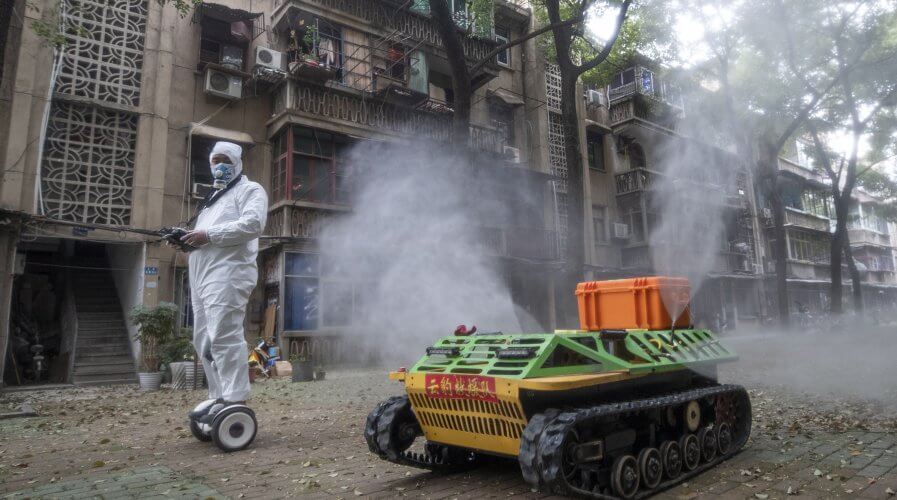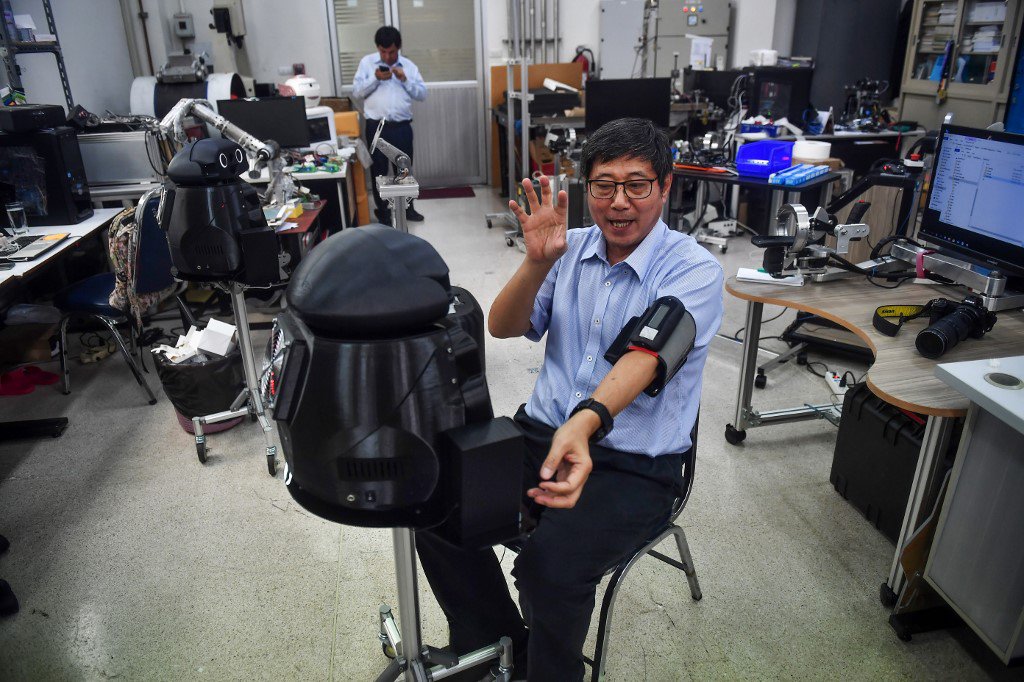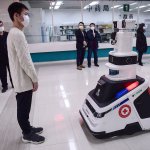
Robots disinfect the streets in Wuhan. Source: AFP
How robots are supporting medical front-liners around the world
Medical front-liners are constantly at risk during the pandemic. Even a routine temperature check now poses a risk of transmission, and that’s just one of the many critical tasks that have to be carried out.
With personal protective equipment (PPE) and other supplies running low across the globe, keeping the risks of human-to-hum contact to a minimum is proving more challenging by the day.
As a result, medical facilities and government bodies have turned to robots for help.
Robots can be common sights in the industrial manufacturing sector or engineering fields, but the technology is increasingly pulling its weight on overburdened hospital floors – they are helping to keep facilities clean, perform basic checkups, and deliver food to patients in the ward.
A surge in demand right now may even lead to further uptake after the crisis subsides, as hospitals understand how workloads can be eased as a result.
Robot application in healthcare
In Thailand, robots are being used to connect doctors to patients for consultations to minimize infection risks. The robots – which look like mini ninjas – were originally programmed to monitor stroke patients.

Professor Viboon Sangveraphunsiri demonstrates the use of medical robots modified to screen and observe COVID-19 coronavirus patients. Source: AFP
As of now, four hospitals in Thailand are utilizing these robots with 10 more to follow.
Spain is following China’s footsteps in deploying robots. The country is committed to increasing the testing of patients but is well-aware that medical professionals are already overburdened. Robots are naturally sought to carry out testing automatically.
The head of Madrid-based Health Institute Carlos III Raquel Yotti had addressed this through a press conference saying: “A plan to automate tests through robots has been already designed, and Spain has committed to buying four robots that will allow us to execute 80,000 tests per day.”
In China, robots in hospitals are a common sight. The technology powerhouse has deployed robots to directly tackle disinfection tasks which could pose very high risks if they were done by humans.
A smart hospital in Wuhan, for example, has made the news for its 5G-powered robots with different specialties. Some of them are in charge of taking the temperature and measure blood oxygen levels while some help deliver medicines to COVID-19 patients.
There are also UV light robots and disinfectant-carrying robots that sanitize hospital areas and other infected areas.
Those equipped with UV-C ultraviolet light are stationed in hospitals, killing viruses, harmful microbes, and bacteria in under 20 minutes, adding efficiency to the medical ecosystem in health emergencies.
A volunteer operates a remote-controlled disinfection robot to disinfect a residential area. Source: AFP
Meanwhile, in Ireland, a hospital has adopted advanced software robots to automate administrative tasks that have consumed nurses’ time. Mater Misericordiae University Hospital expects that the robot will allow nurses to have more time dedicated to attending patients.
The hospital’s Assistant Director of Nursing Jincy Jerry said, “Not only will automation help with [freeing up nurses time], but it will also take the strain off the hospital as it continues to process huge amounts of more routine patient data in addition to Covid-19 specific information.”
Robot markets are charging up
Robot manufacturers are rejoicing the fact that the technology is finally scaling up, especially in China. Although most of these robots were sent as donations to hospitals, the market outlook is definitely promising.
Commercially speaking, robots will be seen as an essential investment on hospital floors once things have settled down.
The potential and benefits that these robots have showcased in various hospitals have opened up new market opportunities while at the same time pushing the technology closer to maturity.
“We are seeing a many, many-fold increase in new demand from hospitals, and a lot of people are calling us for the first time,” said Emil Jensen of Mobile Industrial Robots to The Star.
Juul Nielsen of UVD Robots, on the other hand, told BBC: “We had been growing the business at quite a high pace – but the coronavirus has kind of rocketed the demand.
“Over the past month, our partners from all over the world, particularly in Asia, started ordering hundreds of robots. We’re working as hard as we can to fill all of those orders,” said Morris Miller of Xenex.
READ MORE
- Strategies for Democratizing GenAI
- The criticality of endpoint management in cybersecurity and operations
- Ethical AI: The renewed importance of safeguarding data and customer privacy in Generative AI applications
- How Japan balances AI-driven opportunities with cybersecurity needs
- Deploying SASE: Benchmarking your approach


